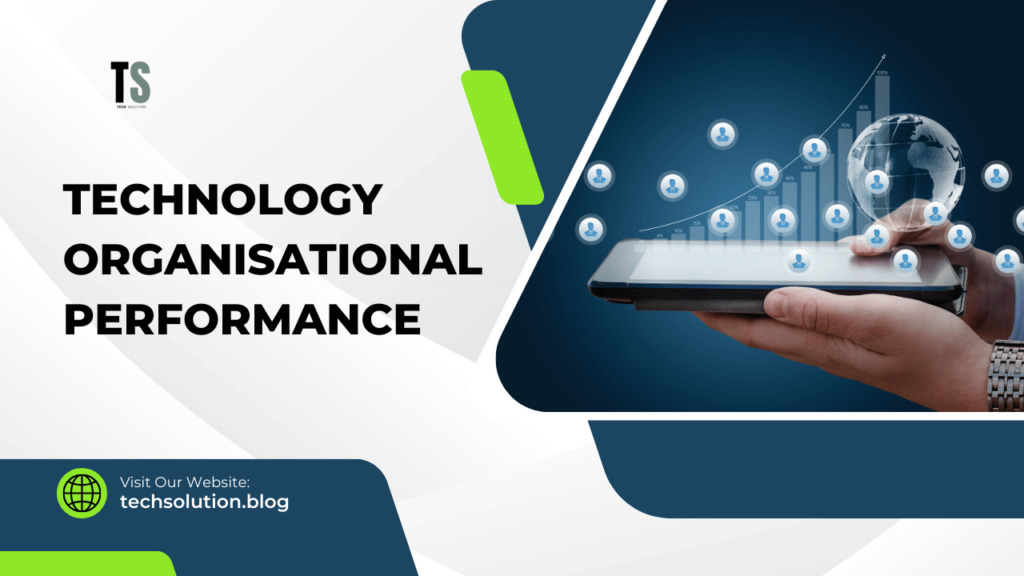Are you ready for a transformation that can propel your organization to new heights? The use of technology has become indispensable to business growth and success. No matter the industry, leveraging the right technology is key to enhancing organizational performance.
From streamlining internal processes to improving customer relations and driving innovation, using technology to improve organizational performance is no longer an option but a strategic necessity.
What is Organisational Performance?
Before delving into how technology improves organizational performance, we must first define what we mean by “organizational performance.” At its core, organizational performance refers to how well a company achieves its set objectives and goals. These objectives include financial profitability, operational efficiency, market share growth, customer satisfaction, and employee productivity.
Traditionally, companies have relied on manual processes and legacy systems to track and measure performance. However, these systems are often inefficient, prone to human error, and unable to cope with the fast pace of today’s business environment. This is where technology steps in.
The Role of Technology in Today’s Businesses

When it comes to business success, technology is not just an enabler—it’s a driver. The use of technology to improve organisational performance involves integrating tools that enhance productivity, communication, data management, and overall workflow efficiency. Whether through automation, cloud computing, artificial intelligence (AI), or data analytics, the right technological tools can fundamentally change how businesses operate.
Technology helps organizations minimize redundant tasks, reduce operational costs, increase accuracy, and improve internal and external communication.
Additionally, technology empowers businesses to become more agile, respond quickly to market changes, and make data-driven decisions. As a result, organizations that effectively implement technological solutions are better positioned to compete in the market.
1. Enhancing Productivity with Technology
One of the most noticeable impacts of technology is its ability to improve productivity. Gone are the days when manual processes slowed down the flow of work. Today, automation tools and software can take over repetitive tasks, freeing up employees to focus on more strategic and creative initiatives.
Consider the rise of customer relationship management (CRM) systems. CRMs help businesses organize customer information, track interactions, and manage sales pipelines. This technology improves productivity by eliminating manual data entry and helps companies better understand their customers’ needs and tailor their approach accordingly.
Similarly, enterprise resource planning (ERP) systems help streamline business operations by automating various functions such as inventory management, human resources, and accounting. With ERP systems, businesses can consolidate operations, enhance collaboration across departments, and gain real-time insights into performance metrics.
The use of technology to improve organisational performance in this context is undeniable. With automation and integrated systems, employees can do more in less time, increasing output without sacrificing quality.
2. Improving Communication and Collaboration
Effective communication is crucial to organizational success, and technology has revolutionized how teams connect and collaborate. Whether it’s through cloud-based platforms, video conferencing tools, or instant messaging apps, technology has made it easier for teams to share ideas, collaborate on projects, and stay connected, regardless of their physical location.
In the past, businesses relied heavily on face-to-face meetings or lengthy email threads to communicate. However, modern organizations use tools like Slack, Microsoft Teams, and Zoom to streamline communication. These platforms allow teams to share files, discuss projects, and even integrate other tools like project management software, ensuring seamless workflow collaboration.
In an increasingly common remote work era, the ability to communicate effectively across geographical boundaries is a major advantage. By adopting the right technology, companies can ensure that their teams remain productive, aligned, and engaged, no matter where they work.
Additionally, collaboration tools enhance transparency within an organization. Cloud-based document sharing and project management software allow teams to work together in real-time, track project progress, and keep everyone in the loop. This boosts organizational performance by reducing the time spent on back-and-forth communication and ensuring that everyone has access to the information they need when they need it.
3. Data-Driven Decision Making
When it comes to decision-making, intuition and experience are important, but data is king. Technology has made it easier than ever for organizations to collect, analyze, and interpret vast amounts of data. With the rise of big data analytics, businesses can now make more informed decisions, identify trends, and uncover insights that were previously out of reach.
For example, companies that leverage data analytics can track customer behavior, measure campaign performance, and optimize marketing efforts. Tools like Google Analytics or more advanced platforms such as Power BI and Tableau allow organizations to visualize data in a way that makes it easy to identify opportunities for improvement.
The use of technology to improve organisational performance extends to real-time data analysis. By monitoring key performance indicators (KPIs) in real-time, businesses can respond more quickly to challenges or capitalize on emerging trends. This ability to make data-driven decisions empowers organizations to stay ahead of the competition and continuously refine their growth strategies.
Moreover, artificial intelligence (AI) and machine learning (ML) are becoming increasingly important tools in this process. AI-powered algorithms can predict customer preferences, optimize pricing strategies, and even automate decision-making processes based on historical data. By harnessing the power of AI, organizations can further improve their performance and drive innovation.
4. Enhancing Customer Experience
In today’s competitive landscape, customer experience is a major differentiator. Technology can significantly enhance the way organizations interact with their customers. Whether through personalized marketing, faster response times, or seamless e-commerce platforms, businesses can use technology to deliver better experiences at every touchpoint.
One way technology improves customer experience is through the automation of customer support. Chatbots, for instance, allow businesses to provide instant responses to customer inquiries 24/7. This improves customer satisfaction and frees up human agents to handle more complex issues.
Additionally, data analytics allows businesses to better understand customer preferences and behaviors, enabling more personalized marketing campaigns. Whether through email marketing, social media advertising, or personalized product recommendations on e-commerce websites, technology empowers businesses to create targeted, relevant experiences for their customers.
For service-based industries, technology can also streamline the entire customer journey. Appointment scheduling systems, online booking platforms, and mobile apps allow customers to engage with businesses on their terms. This level of convenience enhances customer satisfaction and improves overall organizational efficiency by reducing staff manual workload.
5. Reducing Operational Costs
Another important benefit of the use of technology to improve organisational performance is its ability to reduce operational costs. Technology allows businesses to automate processes, reduce waste, and optimize resources, contributing to cost savings.
For instance, companies implementing cloud-based solutions can eliminate the need for expensive on-premise hardware and reduce maintenance costs. Cloud computing allows businesses to scale their IT resources based on demand, reducing the overhead associated with managing physical servers.
In manufacturing, integrating technology in production processes through robotics and automation has drastically reduced labor costs and increased efficiency. Smart factories equipped with the Internet of Things (IoT) devices can monitor equipment performance, predict maintenance needs, and ensure that production runs smoothly with minimal downtime.
Even in service-based industries, technology can reduce costs by automating administrative tasks. Online invoicing software, payroll systems, and employee management tools all help reduce the time spent on manual tasks, allowing businesses to operate more efficiently.
6. Driving Innovation and Competitive Advantage
Innovation is the lifeblood of any successful business, and technology is a key driver of innovation. By adopting new technologies, businesses can differentiate themselves from competitors, offer new products and services, and enter new markets.
Consider how companies like Tesla have revolutionized the automotive industry with their cutting-edge electric vehicles and autonomous driving technology. Or consider how Amazon has transformed retail, focusing on e-commerce and logistics technology.
The use of technology to improve organisational performance is about more than improving existing processes; it’s about driving innovation. Organizations that stay ahead of technological trends are better positioned to seize new opportunities, adapt to changing market conditions, and create products or services that meet their customers’ evolving needs.
Moreover, technology can open doors to new business models. For instance, the rise of the sharing economy was made possible by advancements in mobile technology and platform-based solutions. Companies like Uber and Airbnb have capitalized on these trends to disrupt traditional industries and create new opportunities for growth.
7. Overcoming Challenges in Technology Adoption
While the benefits of technology are clear, it’s important to acknowledge that adopting new tools and systems can present challenges for organizations. One of the most common challenges is the resistance to change. Employees may be hesitant to embrace new technology, fearing that it could disrupt their workflow or even threaten their jobs.
Companies must focus on change management and provide adequate team training to overcome this. By involving employees in the decision-making process, offering hands-on training, and clearly communicating the technology’s benefits, businesses can ensure a smoother transition and minimize resistance.
Another challenge is the cost of implementing new technology. While the initial investment in technology can be significant, the long-term benefits in terms of increased efficiency, reduced costs, and improved performance often outweigh the upfront expenses. Moreover, businesses can explore financing options or start with smaller, incremental technology upgrades to manage costs effectively.
Lastly, cybersecurity is a growing concern in the digital age. As organizations become more reliant on technology, they must also invest in robust security measures to protect sensitive data and prevent cyberattacks. Implementing strong cybersecurity protocols, conducting regular audits, and educating employees about security best practices are essential steps to mitigate these risks.
Cost Breakdown of Technology Usage

Technology has become integral to daily life, influencing how we work, communicate, and learn. From smartphones to cloud computing, the tools we use are continually evolving.
Businesses rely on advanced software and automation to improve efficiency, while individuals use apps and devices for everything from social networking to personal organization. This widespread adoption of technology has revolutionized industries, making processes faster, more efficient, and more accessible globally.
Here is the Cost Breakdown of Technology Usage:
Technology |
Initial Setup Cost |
Monthly Subscription |
Maintenance Cost |
Training Cost |
Additional Costs |
| Cloud Storage Solutions | $1,000 | $20 – $100/month | $100/year | $500 | Data overage fees |
| Enterprise CRM Systems | $5,000 | $150 – $500/month | $300/year | $1,000 | Custom integrations |
| Remote Video Monitoring | $2,500 | $200 – $400/month | $250/year | $600 | Additional cameras |
| Website Hosting Service | $100 – $500 | $5 – $30/month | $50/year | Free tutorials | Domain Registration |
| E-Commerce Platforms | $2,000 | $30 – $300/month | $200/year | $700 | Payment gateway fees |
| AI Chatbots | $3,000 | $100 – $400/month | $150/year | $500 | API usage costs |
Conclusion
The use of technology to improve organisational performance is a powerful strategy that enables businesses to become more efficient, agile, and competitive. From enhancing productivity and communication to driving innovation and reducing costs, technology offers numerous advantages that can transform organizations’ operations.
As we move into the digital age, organizations that embrace technology and adapt to new trends will be better positioned to thrive in an increasingly competitive marketplace. Whether through automation, data analytics, or customer experience tools, the right technology can unlock new performance levels and drive long-term success.
So, are you ready to leverage technology to elevate your organization’s performance? The time to act is now. Embrace the power of technology, and watch your business soar to new heights!



